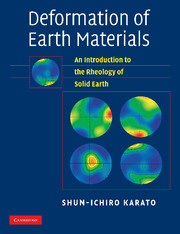Book contents
- Frontmatter
- Contents
- Preface
- Part I General background
- Part II Materials science of deformation
- 4 Elasticity
- 5 Crystalline defects
- 6 Experimental techniques for study of plastic deformation
- 7 Brittle deformation, brittle–plastic and brittle–ductile transition
- 8 Diffusion and diffusional creep
- 9 Dislocation creep
- 10 Effects of pressure and water
- 11 Physical mechanisms of seismic wave attenuation
- 12 Deformation of multi-phase materials
- 13 Grain size
- 14 Lattice-preferred orientation
- 15 Effects of phase transformations
- 16 Stability and localization of deformation
- Part III Geological and geophysical applications
- References
- Materials index
- Subject index
- Plate section
6 - Experimental techniques for study of plastic deformation
Published online by Cambridge University Press: 05 June 2012
- Frontmatter
- Contents
- Preface
- Part I General background
- Part II Materials science of deformation
- 4 Elasticity
- 5 Crystalline defects
- 6 Experimental techniques for study of plastic deformation
- 7 Brittle deformation, brittle–plastic and brittle–ductile transition
- 8 Diffusion and diffusional creep
- 9 Dislocation creep
- 10 Effects of pressure and water
- 11 Physical mechanisms of seismic wave attenuation
- 12 Deformation of multi-phase materials
- 13 Grain size
- 14 Lattice-preferred orientation
- 15 Effects of phase transformations
- 16 Stability and localization of deformation
- Part III Geological and geophysical applications
- References
- Materials index
- Subject index
- Plate section
Summary
An understanding of the experimental techniques of study of plastic deformation is important not only for those who wish to conduct deformation experiments but also for those who would like to apply experimental data on plastic deformation for geological, geophysical and geochemical studies. There is a range of techniques that have been used and each of them has some advantages and limitations. This chapter provides a brief summary of the basic techniques used in experimental studies of plastic deformation. They include mechanical tests under high pressure and temperature using a standard tri-axial testing apparatus as well as large-strain torsion apparatus and some of the recently developed ultrahigh-pressure (> 10 GPa) deformation apparatus. Key issues in sample preparation and characterization are also reviewed including the control of the chemical environment.
Key words gas-medium deformation apparatus, solid-medium deformation apparatus, load cell, X-ray in-situ stress/strain measurement, constant stress (strain-rate) test, hardness test, stress-relaxation test, stress-dip test, compression (tension) test, torsion test.
Introduction
Experimental techniques of deformation studies in Earth sciences involve (1) the generation and characterization of Earth-like thermodynamic conditions (pressure, temperature, chemical environment), (2) the controlled generation of differential stress (or strain) and (3) the measurements of stress and strain. Therefore an experimental set-up usually consists of an environmental chamber (sample assembly) in which a desired thermodynamic environment (e.g., pressure, temperature, fugacity of water, fugacity of oxygen etc.) is established, and an actuator to generate differential stress, and some sensors to measure strain and/or stress, temperature and pressure (Fig. 6.1).
- Type
- Chapter
- Information
- Deformation of Earth MaterialsAn Introduction to the Rheology of Solid Earth, pp. 99 - 113Publisher: Cambridge University PressPrint publication year: 2008



